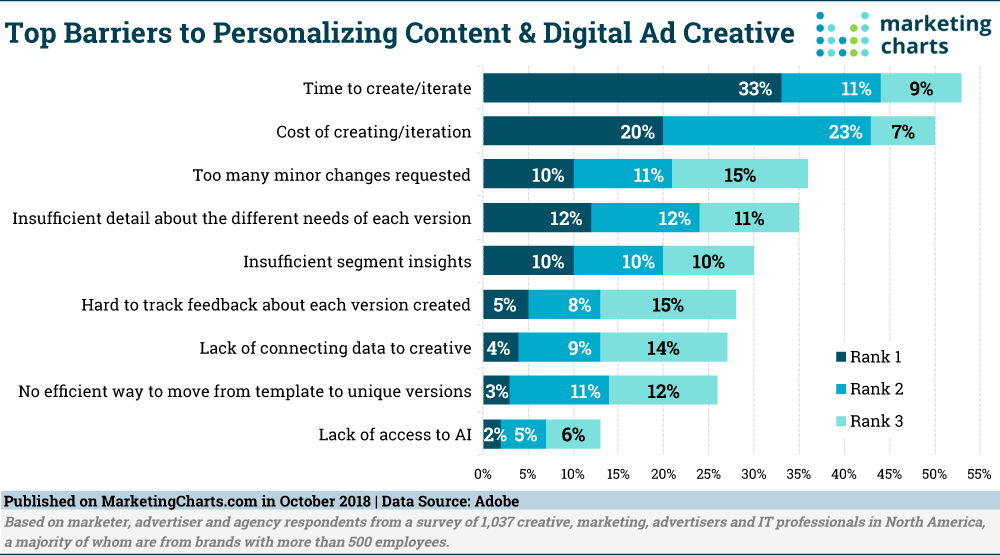This winter break reading list is designed to help CMOs start the new year sharper, more informed, and ahead of the competition

Marketers today know how critical personalization is to capturing audience attention, engaging them, and influencing them to become customers. That said, the realities and results of investing in personalization are not so simple.
Gartner research predicts 80% of marketers who invest in personalization will abandon their efforts by 2020.
If personalization is so valuable, why let it go?
The issue lies in two key areas:
Here’s what your business can do to avoid these perils and scale your personalization strategy:
There’s a wealth of relevant consumer data businesses can utilize to better target and market to their audience. However major regulations like GDPR and the California Privacy Act have caused many businesses to shy away from using personal identity data from their audience.
This is causing issues for businesses that want to scale their personalization strategy. In fact, 27% of marketers say data is a key obstacle to personalization in advertising.
Utilizing identity data to track leads and personalize your advertising strategy is incredibly valuable. However, you must be prepared to manage your data in a way that complies with consumer privacy laws.
The truth of the matter is, regulatory laws are going nowhere, and marketers need to adapt their strategy so they can utilize all the relevant data they need to effectively target their audience. Instead of relying on walled gardens for audience insights, start considering how you can legally manage your own audience identity data. Start by learning the requirements, then adapting your data collection and management strategy to match.
Securing all necessary audience data isn’t the only solution to scaling personalization. You also need the capacity to personalize content (ad copy, landing pages, and other digital creative). This requires considerable time and resources, making major challenges to scaling personalization. According to an Adobe survey, marketers rank time to create content as the top barrier to personalizing content:

So, what’s the solution?
When searching for more time, the best course of action is to evaluate your internal processes to find ways to improve efficiency. Take a full audit of how your marketing team functions to see if there’s any way to improve time management. Also consider if any tasks can be automated. Even if they don’t relate directly to personalization efforts, freeing up time normally spent on other administrative tasks gives your team an opportunity to reallocate that towards marketing.
With that in mind, there are also quite a few aspects of ad personalization that can be automated. Using Dynamic Search Ads (DSAs) is one example. Available for both Google and Bing, Dynamic Search Ads automatically generate ad content based on your website copy. So if you have a lot of landing pages personalized towards different audience segments, DSAs can help you create relevant ad copy to match them.
Headlines and display URLs can also be dynamically generated, personalizing ads based on the search queries people use to find your business. Automatically generating ad copy can improve marketing efficiency by saving time on the creation of ads. They can also improve campaign performance by delivering a more relevant message and helping businesses fill gaps in their keyword targeting strategy.
Utilizing Google Ad’s internal features to scale your personalization strategy is a start. However, there’s a lot you can also do to improve campaign efficiency and effectiveness using third-party tools as well.
Two key areas to which to allocate budget are analytics and operational technologies. If you’re going to utilize all relevant audience data to inform your targeting and personalization strategy, you need powerful analytics technology to process it.
The more data you utilize, the more opportunities to optimize and scale your personalization strategy. However, this also requires more time manually analyzing data and adjusting your campaigns. The most valuable analytics technologies offer automation features that help marketers analyze data and find the most relevant insights, fast.
Equally important to advanced analytics are operational technologies. These are tools that can help you automate adjustments to your marketing campaigns based on the latest data insights.
The value of your data insights won’t matter unless you can act on them and do so quickly. So make sure you’re budgeting for the right analytics and management tools you need. Having gaps here makes your program less efficient, leaving numerous barriers to scaling personalization.
Personalization in advertising is so often touted as the key to marketing success to a degree that business leaders set personalization goals beyond what they can handle. More importantly, these goals are beyond the scope of what you need to successfully scale your personalization strategy.
Not every single piece of content you create needs to be completely personalized to individual audience members. It’s more important at certain stages of your sales funnel. With that in mind, you can set up strategic objectives to prioritize personalization at key points along the customer journey.
Personalization in advertising doesn’t have to be an all-or-nothing strategy. Start by taking a hard look at your marketing goals and decide what you need to personalize to achieve them. Over time, as you learn how personalization strategies influence your unique audience, you can adjust your strategy and scale it as needed. This is the most important factor that can help marketers illustrate ROI from their personalization efforts in the short and long term.
Personalization is a complex marketing strategy that won’t drive much ROI for businesses unless they break down barriers to scaling it. Using the right approach, it’s possible to avoid these pitfalls and maximize the value of personalization to reach key marketing goals. Just remember to use all relevant data you can, improve the efficiency of your marketing program, invest in the right tools, and set realistic goals for success.
~
To learn more about how our omnichannel DSP can empower you to implement unrivaled levels of personalization throughout your campaigns, get in touch with our digital media experts today.